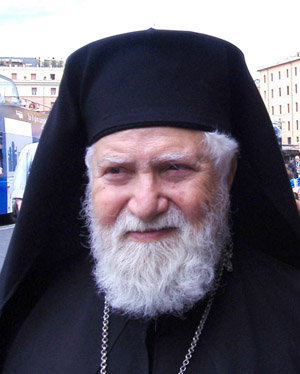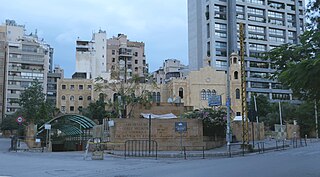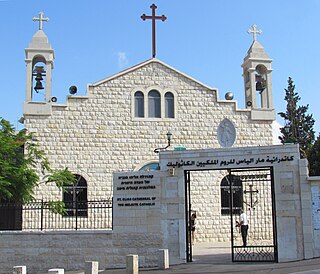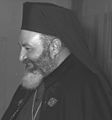
The Melkite Greek Catholic Church, or Melkite Byzantine Catholic Church, is an Eastern Catholic church in full communion with the Holy See as part of the worldwide Catholic Church. Its chief pastor is Patriarch Youssef Absi, headquartered at the Cathedral of Our Lady of the Dormition in Damascus, Syria. The Melkites, who are Byzantine Rite Catholics, trace their history to the early Christians of Antioch, formerly part of Syria and now in Turkey, of the 1st century AD, where Christianity was introduced by Saint Peter.

Gregory III Laham, B.S., Emeritus Patriarch of Antioch and All the East, of Alexandria and Jerusalem, is the former spiritual leader of the Melkite Greek Catholic Church. He was elected on November 29, 2000, succeeding Patriarch Maximos V Hakim. He retired on May 6, 2017.

Maximos V Hakim was elected Patriarch of Antioch and All the East, and Alexandria and Jerusalem of the Melkite Greek Catholic Church in 1967 and served until 2000. He guided the church through turbulent changes in the Middle East and rapid expansion in the Western hemisphere.
Maximos IV Sayegh was a Syrian Catholic prelate who served as Patriarch of Antioch and All the East, and Alexandria and Jerusalem of the Melkite Greek Catholic Church from 1947 until his death in 1967. One of the fathers of Second Vatican Council, he stirred attendees by urging reconciliation between the Catholic and Eastern Orthodox churches. He accepted the title of cardinal in 1965 after Pope Paul VI clarified the significance of that title in the case of an Eastern patriarch.
Cyril IX Moghabghab served as Patriarch of Antioch and All the East, and Alexandria and Jerusalem of the Melkite Greek Catholic Church from 1925 to 1947.

John Adel Elya was a bishop of the Melkite Greek Catholic Church. From 1993 to 2004, he served as Eparch of Newton, with jurisdiction over Melkite churches in the United States.

Demetrius I Qadi was Patriarch of Antioch and All the East, and Alexandria and Jerusalem of the Melkite Greek Catholic Church from 1919 until 1925.
Patriarch Cyril VI Tanas, also known as Cyril VI of Antioch, became the first Patriarch of Antioch and All the East, and Alexandria and Jerusalem of the Melkite Greek Catholic Church following the schism of the Greek Orthodox Patriarchate of Antioch in 1724. Cyril re-established full communion with the Catholic Church.

Patriarch Gregory II Youssef, also known as Gregory II Hanna Youssef-Sayour, was Patriarch of the Melkite Greek Catholic Church from 1864 to 1897. Gregory expanded and modernized the church and its institutions and participated in the First Vatican Council, where he championed the rights of the Eastern Catholic Churches.
The Basilian Order of the Most Holy Saviour abbreviated BS, also known as the Basilian Salvatorian Order, is an Eastern Catholic monastic order of Pontifical Right for men of the Greek-Melkite Catholic Church. The name derives from its motherhouse, the Holy Saviour Monastery, at Joun in Chouf near Sidon, Lebanon.
Maximos II Hakim, was Patriarch of the Melkite Greek Catholic Church from 1760 to 1761.
Theodosius V Dahan (1698–1788) was Patriarch of the Melkite Greek Catholic Church from 1761 to 1788.
Athanasius IV Ignace Michael Jawhar was Patriarch of the Melkite Greek Catholic Church from 1788 to 1794. He previously claimed to be patriarch from 1759 to 1764 and from 1765 to 1768.

The Archeparchy of Beirut and Byblos is a metropolitan eparchy of the Melkite Greek Catholic Church since 1881, an Eastern Catholic church in communion with the Roman Catholic Church. Located in Lebanon, it includes the cities of Beirut and Byblos, and in terms of population, it is the largest Melkite eparchy in the Middle East. Its current Eparch, Georges Wadih Bacouni, S.M.S.P., was elected in November 2018.
Georges Kwaïter was an Archeparch of the Melkite Greek Catholic Archeparchy of Sidon.

Melkite Greek Catholic Archeparchy of Akka is an Eastern Catholic diocese of Melkite Greek Catholic Church, directly subject to the Melkite Catholic Patriarchate of Antioch. Its Cathedral episcopal see is St. Elijah Greek-Melkite Cathedral, in Haifa.
Jean-Abdo Arbach, B.C., is the current archeparch of the Melkite Greek Catholic Archeparchy of Homs, Hama and Yabroud.
Melkite Greek Catholic Archeparchy of Bosra and Hauran is an archeparchy of the Melkite Greek Catholic Church with its territory located in Syria. It is currently governed by Archeparch Nicolas Antiba, BA.
Melkite Greek Catholic Archeparchy of Homs is a nominally Metropolitan Archeparchy of the Melkite Greek Catholic Church in central Syria. It was established on March 4, 1849 and has no suffragan, but two merged-in eparchial titles.

Youssef Absi is the current patriarch of the Melkite Greek Catholic Church, serving since June 21, 2017.




















